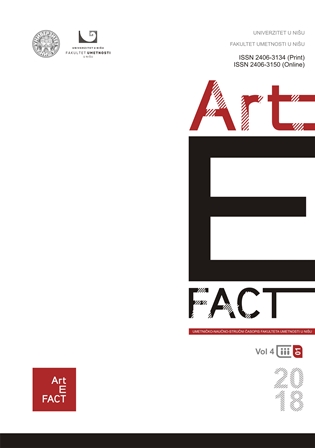SKIN MOBILITY AND FACIAL EXPRESSIONS IN SCIENCE AND ART
Abstract
Skin as a phenomenon includes a variety of terms such as skin intelligence, skin erection, skin shyness, skin fantasy and memories, character armor, skin flickering, trans-flicker, thickskin. Within their meaning they are all connected by one common thread: communication through skin. Skin communicates via ''drawing'' which can be seen on it: engraved lines, streaks, dots, channels, complex line systems, glow, flickerings... That is the ''natural drawing'' as the anatomy names it and describes it.
The basic trait of a natural skin drawing is movement and its incessant transforming. The mobility of facial skin exceeds that of skin of any other body part.
Skin transformation entails posing a series of questions: specific mechanisms of the natural drawing, its psychical meaning, the question of true causes, constancy or mobility of the drawing, meaning, purpose of mobility, why of all the organs the skin stands out as crucial to understanding human body or man, in the field of science as well as in the art field.
Studying the natural drawing on the skin, within art is possible to remodel into meanings and systematically fill up by examining its mobility.
Even by only naming the phenomena and terms related to human skin we get an insight into the broadness of the subject, however the idea of the text is to carry out a systematization of the abovementioned phenomena similar to an illustrated poetic-anatomy glossary which, in this case, brings us closer to the facial skin phenomenon as the most extreme one when it comes to mobility.
The illustrations which are embedded in the text are literally examples from art in the form of drawings, sculptures and photographs, only the verbal part of the text which explains less adopted scientific terms related to skin such as: Character armor, Skin erection, Skin memories, which contribute to feeling the importance of the skin in communication more intensely, can also be subsumed under the illustration. Reading scientific texts can lead to fine art solutions and allow for deeper and invisible connections to be experienced. By its difficulty the term Natural drawing, which is adopted in the medical anatomy textbook, especially stands out and creates a connection between two areas of human activities, anatomy and art.
Involved features on the skin of the human body in their apparent heterogeneity are unified by movement as their common feature, a feature which is the main quality of life from the scientific as well as from the artistic point of view. Reduced to its most simple formula, the causes of skin mobility are of indivisible psychosomatic origin. True cause of movement is rush: the rush of life, rush of tears, rush of sexual urges, rush of moral barriers, rush of passion, rush of aggressiveness, rush of thrill, rush of air, rush of lying. It can most easily be seen on the face, because facial skin is a projection surface on which even the slightest emotion is shown as the first signal. Interpreting those movements has its own practical purpose in judiciary, criminology, medicine, art, as well as in everyday communication.References
Bašlar, G. (2001). Vazduh i snovi: ogled o imaginaciji kretanja, Novi Sad: Izdavačka knjižnica Zorana Stojanovića Sremski Karlovci.
Dalke, R. (2012). Bolest kao put, Beograd: Laguna.
Epštejn, M. (2009). Filozofija tela, Beograd: Geopoetika.
Kris, E. (1970). Psihoanalitička istraživanja u umetnosti, Beograd: Kultura.
Le Brun, Ch. (1732). Expressions des passions de l’Ame, [elektronska verzija] Munich: Martin Engelbrecht.
Matorkić, E. (2014). Oponašanje prirodnog crteža ljudske kože – tehnike vizualizacije nevidljivih otisaka. Neobjavljena doktorska disertacija, Univerzitet umetnosti u Beogradu, Fakultet likovnih umetnosti.
Reich, W. (1990). Funkcija orgazma, Beograd: Mladost.
Šljivić, B. (1973). Sistematska i topografska anatomija – glava i vrat sa čulnim organima, Beograd – Zagreb: Medicinska knjiga.
Artefact omogućava otvoreni pristup i, u skladu sa preporukom CEON-a, primenjuje Creative Commons (CC BY) odredbe o autorskim pravima:
Autori koji objavlјuju u Artefact-u pristaju na sledeće uslove:
a) Autori zadržavaju autorska prava i pružaju časopisu pravo prvog objavlјivanja rada i licenciraju ga Creative Commons licencom koja omogućava drugima da dele rad uz uslov navođenja autorstva i izvornog objavlјivanja u ovom časopisu.
b) Autori mogu izraditi zasebne, ugovorne aranžmane za neekskluzivnu distribuciju rada objavlјenog u časopisu (npr. postavlјanje u institucionalni repozitorijum ili objavlјivanje u knjizi), uz navođenje da je rad izvorno objavlјen u ovom časopisu.
c) Autorima je dozvolјeno i podstiču se da postave objavlјeni rad onlajn (npr. u institucionalnom repozitorijumu ili na svojim internet stranicama) pre i tokom postupka prijave priloga, s obzirom da takav postupak može voditi produktivnoj razmeni ideja i ranijoj i većoj citiranosti objavlјenog rada (up. Efekat otvorenog pristupa).

